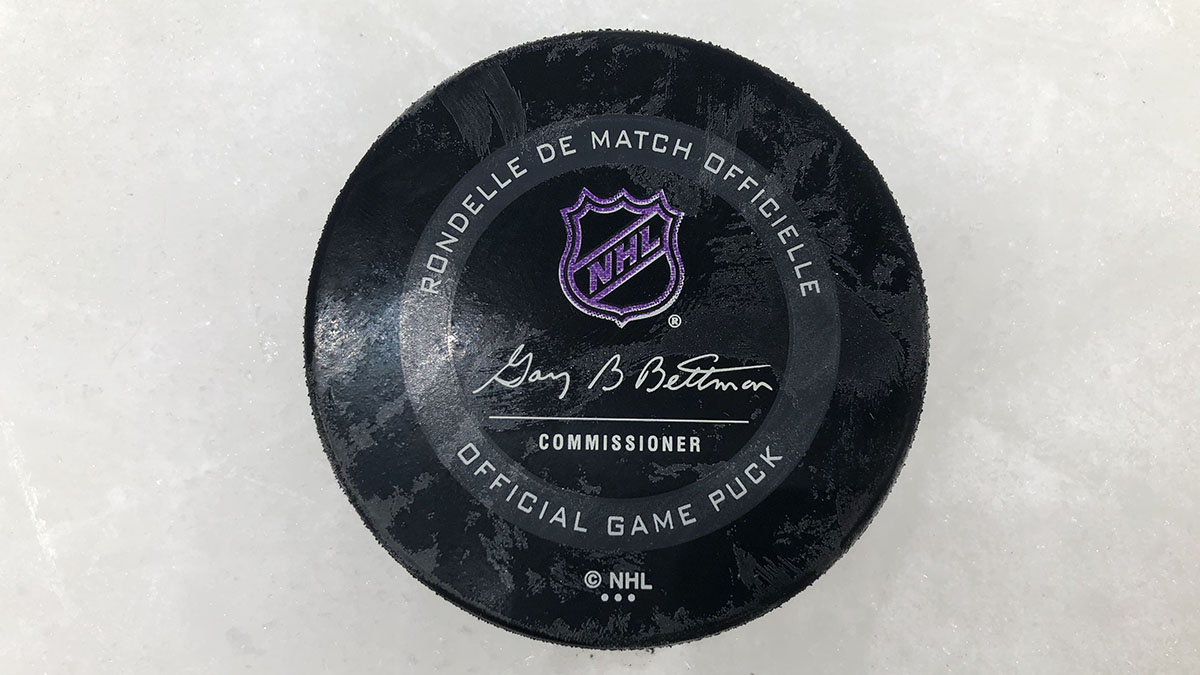If it's purple, it's perfect: NHL using thermochromic coating to ID ideal puck temp

A puck that changes colors? Welcome to the latest and greatest technological advancement with the National Hockey League’s rubber disk.

The 2019-20 hockey season began with pucks with a thermochromic coating that is purple when frozen, but as the puck thaws and reaches above-freezing temperatures, the coating color will become clear. That change should make it easier for officials to identify when the pucks on the ice should be replaced.
It’s part of a three-year deal between the NHL and PPG, a paint supplier based in Pittsburgh that developed the coating with the help of LCR Hallcrest and QCR Solutions. After testing it in the 2019 Winter Classic, the league felt ready to debut the innovation across the continent.
“We are excited to extend our partnership with PPG, a leader in the paint industry and committed NHL partner that activates across many levels of our game,” NHL Group Vice President of Partnership Marketing Evin Dobson said. “Integrating thermochromic coating pucks in all NHL games is a testament to PPG, LCR and QCR’s innovative technology.”
Patrick Schuler, manager of ice operations at Gila River Arena where the Arizona Coyotes play, said: "There is a range the league likes (the puck) between about 14 and 20 degrees with 18 being the preferred temperature."
The idea behind changing out the defrosted pucks is that warmer pucks tend to bounce more and are more difficult to control. In the modern NHL, an average game will use around a dozen pucks.
“Hockey pucks are made of vulcanized rubber and glide smoother and faster when frozen,” NHL Vice President of Facilities Operations Dan Craig said ahead of its trial run at the 2019 Winter Classic. “Freezing a puck eliminates bouncing, and game officials monitor the puck for temperature changes that affect performance while in play. A coating that changes color when the puck is above freezing will more accurately alert the officials that it is time for a replacement.”
It falls in line with the league’s continued push to be on the front end of technological innovation, even with the added difficulty that its sport’s constantly changing players on ice gives them. The league is planning on deploying a puck-and-player tracking system in 2019-20, using RFID tags in the puck and on players’ pads to follow them. It’s been tested a few times so far, including during two Vegas Golden Knights games in January.
“I think they have 20-25 pucks inside the penalty box there and after every TV time out and every goalie stop they change them out” said the Arizona Coyotes' Christian Fischer.
The NHL has been willing to experiment with its puck before, even as far back as the mid-1990s. When Fox Sports had the television rights to the 1996 NHL All-Star Game, it introduced the “glowing puck,” which used infrared technology to follow LED lights inside the puck and have a bright light on and trailing the puck on television.
While the system, officially known as FoxTrax, only lasted two years at the time and was considered “one of the worst ideas in sports” for a long time, it’s regaining popularity, and national hockey writer Greg Wyshynski recently advocated for the glow puck to return on ESPN.
The idea for the thermochromic coating follows a recent pattern most often seen in the beer industry, as Coors Light famously had its label’s “mountains turn blue” when the beer is at the perfect temperature. While that label was set to change in the 40º to 44º F range, the NHL pucks’ label will change once the puck’s temperature rises above freezing.
Alex Simon is a masters sports journalism student at Arizona State University
Senior sports journalism major Nick White contributed to this story
An earlier version of this story had repeated paragraphs.

